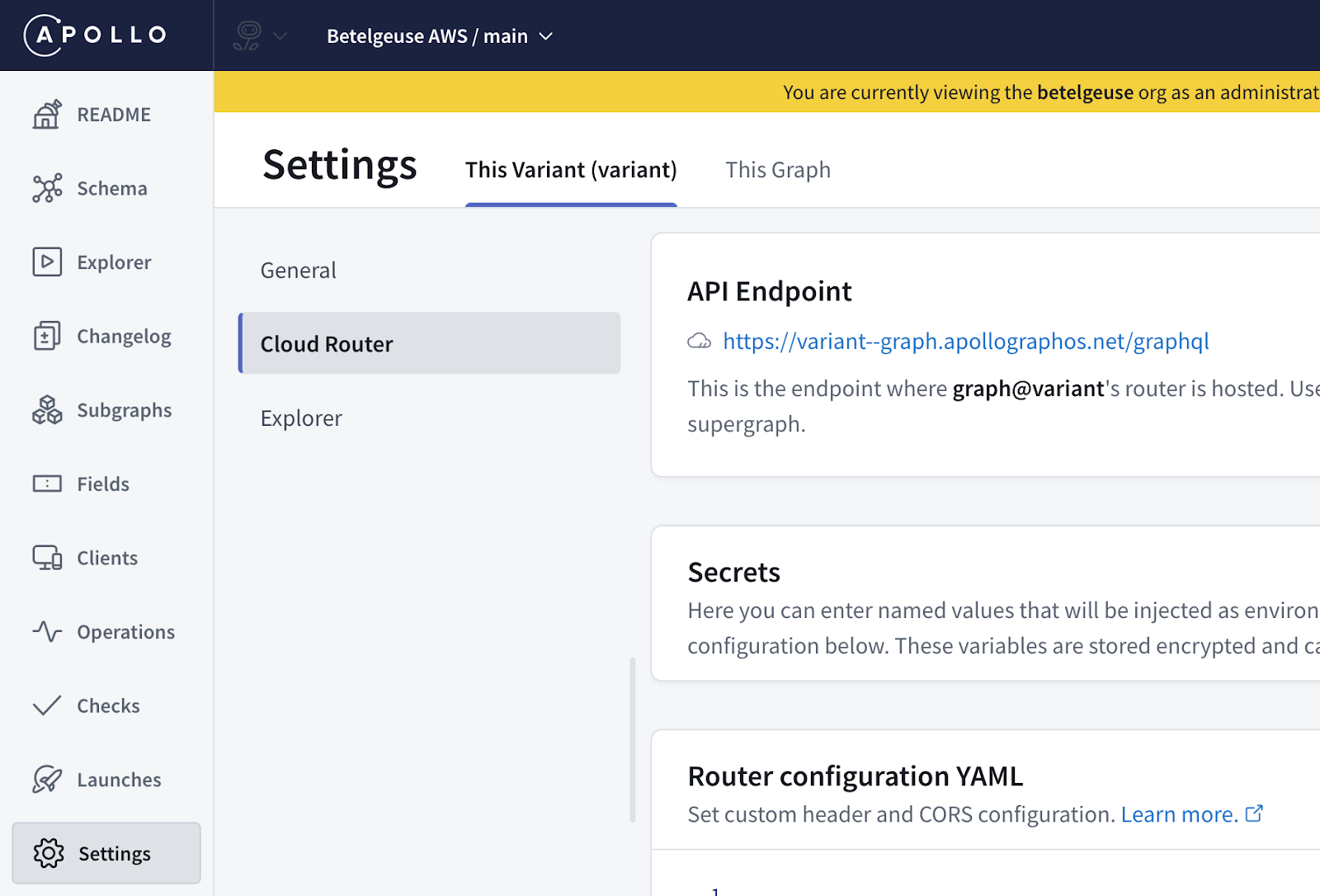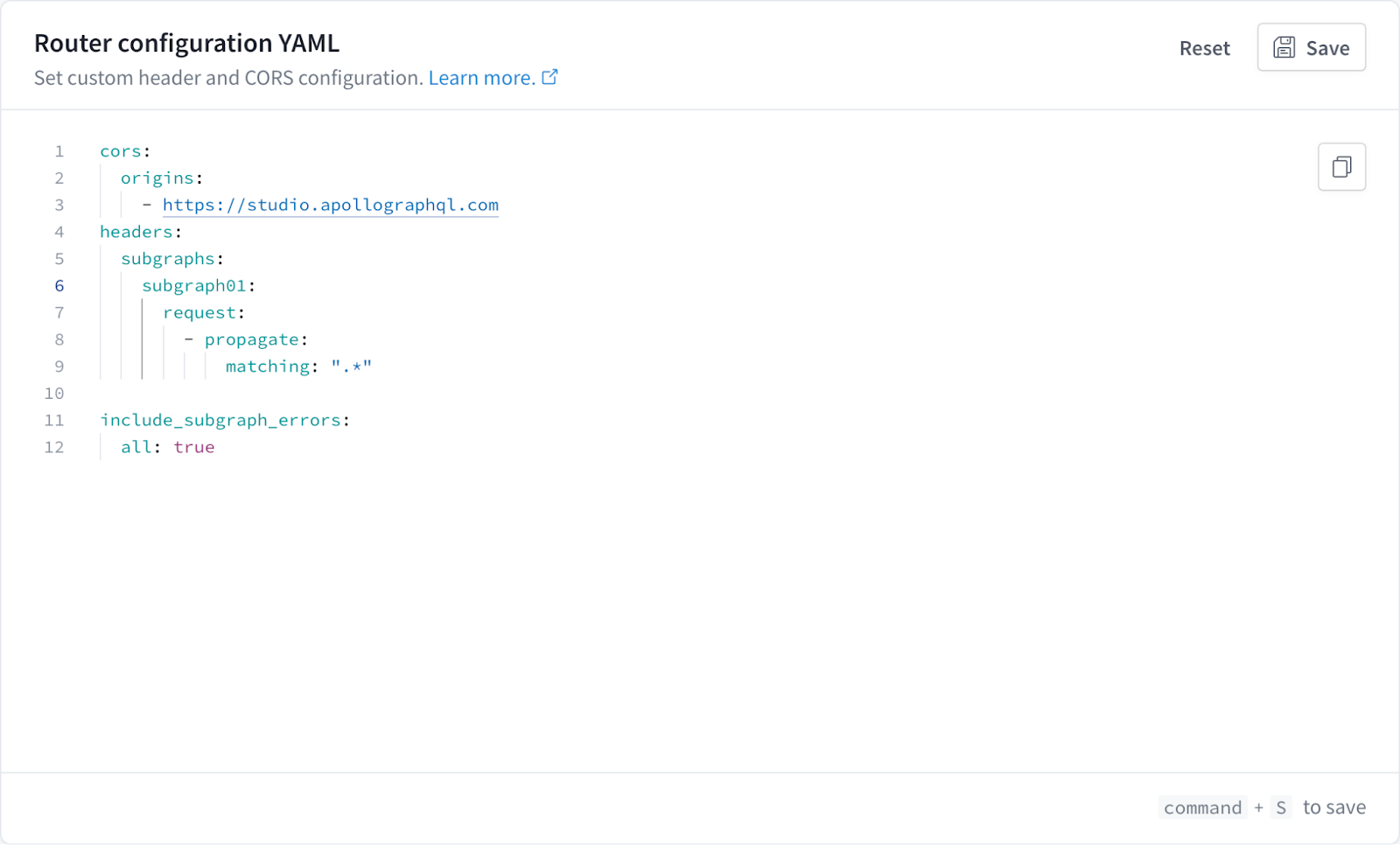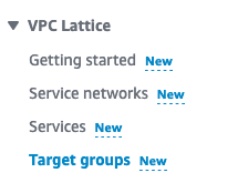AWS Lattice troubleshooting guide
Troubleshoot common issues and errors with AWS Lattice
Cloud Dedicated is currently in invite-only preview. Don't hesitate to get in touch if you'd like to request access or have any questions or feedback.
To learn how to configure AWS VPC Lattice to send traffic to your subgraphs, refer to the configuration docs.
Enable subgraph error inclusion
To help resolve AWS VPC Lattice connection issues, we recommend enabling subgraph error inclusions for your graph variant during troubleshooting. This configuration lets you see error messages generated by your subgraphs. Follow these steps to do set the configuration:
Go to GraphOS Studio.
Navigate to the Settings page for your graph variant.

- In the left sidebar menu, click Settings, then on Cloud Router to access the GraphOS Cloud settings page.

- In the Router configuration YAML section, ensure that the following configuration block that sets
include_subgraph_errorsis present:
include_subgraph_errors:all: true
- Click the Save button in the top right corner of that section.

Configuration changes trigger a new launch. Please wait a few minutes for your cloud router to update with this new configuration. You can monitor the deployment status in the Launches page for your graph variant.
Once you've identißfied and resolved the underlying issue, we recommend you disable subgraph errors by removing the block that sets include_subgraph_errors and saving the Router configuration YAML again.
Common issues and errors
If you encounter an error or not listed below and need assistance, don't hesitate to get in touch. We're here to help.
Service in resource share doesn't appear in private subgraphs
Cloud Dedicated does not automatically scan your resource shares for new Lattice services. If you add a service, you can manually trigger a scan by going to your Apollo Organization settings page and clicking the Rescan subgraphs button.
Providing Authorization headers
Because AWS Sigv4 relies on the HTTP Authorization request header for signing requests, you may receive an error like this: You must be authenticated to access this resource. Please provide a valid Bearer Token in the Authorization header.
If your subgraphs rely on the Authorization header for authentication, your router needs to rename it. For example:
# ...other configuration...headers:all: # Header rules for all subgraphsrequest:- propagate:named: 'Authorization'rename: 'X-Authorization'
Then, ensure you update your subgraphs to check for either Authorization or your new header name.
Error trying to connect: Connection reset by peer (os error 104)
This error is likely to occur when your cloud router tries to send traffic to a port different from the listener on your AWS VPC Lattice service. Apollo GraphOS Cloud only supports communicating with private subgraphs over HTTPS on port 443.
You can validate that your Lattice services are configured to receive traffic on the right port by navigating to the service routing page:
In the AWS Console for your region of choice, go to the VPC service page.
In the menu on the left, scroll down and open Services in the VPC Lattice section.

- Click the name of the Lattice service leveraged by the subgraph in question.

- Click the Routing tab.

- Validate that you have a listener with a
protocol:portconfiguration of HTTPS:443.
If this is not the case, you must create a new listener by clicking on the Add listener button at the top left of this section.
HTTP fetch failed from 'subgraph': 403: Forbidden
This error likely occurs for one of the following reasons:
- One of your clients is sending a subscription request to a private subgraph over WebSockets.
- The VPC Lattice IAM Policy does not allow traffic from Apollo GraphOS Cloud.
Subsriptions over WebSockets
Subscriptions over WebSockets are not supported in AWS VPC Lattice, as the platform lacks WebSocket support at this time. When sending a request to upgrade to a WebSockets connection, Lattice will return a blank response with a 403 response code. In this situation, Lattice will also not emit access log entries to Amazon CloudWatch Logs. We recommend you contact your AWS account team to notify them of your interest in this feature.
VPC Lattice IAM Policy
You can validate that your Lattice services are configured to allow traffic from Apollo GraphOS Cloud by navigating to the service access page:
In the AWS Console for your region of choice, go to the VPC service page.
In the menu on the left, scroll down and open Services in the VPC Lattice section.

- Click the name of the Lattice service leveraged by the subgraph in question.

Click the Access tab.
Ensure that the Auth type is set to IAM and that the policy looks like this:
{"Version": "2012-10-17","Statement": [{"Effect": "Allow","Principal": "*","Action": "vpc-lattice-svcs:Invoke","Resource": "*","Condition": {"ForAnyValue:StringLike": {"aws:PrincipalOrgPaths": "o-9vaxczew6u/*/ou-leyb-l9pccq2t/ou-leyb-fvqz35yo/*"}}}]}